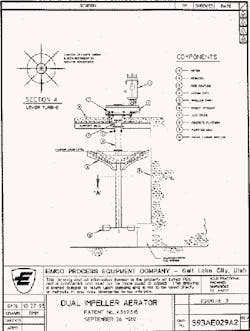Company Offers Dual-Impeller Aerator System
When asked to recommend a 3.0 mgd EIMCO® Carrousel®System oxidation ditch layout for a narrow site, 120 feet wide by 235 feet long, bordered on one side by a rock cliff and on the other by a railroad track, Baker Process selected EIMCO's dual-impeller aerator for the project.
The approach of PEH Engineers/H.A. Spalding Engineers further minimized site dimensions at the City of Hazard, Ky., Wastewater Treatment Plant (WWTP) by situating the process buildings atop the basin channels. These include the influent screening, laboratory, solids dewatering, disinfection and office.
At 16 feet 6 inches deep, the Carrousel®System was constructed and has been operating since 1997.
The dual-impeller aerator used for the project features a specialized lower turbine affixed to the bottom of the same shaft as the surface aerator. Locating the lower turbine near the floor of the basin directs mixing energy along the floor, thus augmenting channel velocities provided by the surface impeller. This allows operation at lower power intensities and permits deeper basins, improved mixing, and better power turndown capability.
Power turndown can be increased to greater than 80 percent with the dual-impeller aerator. WWTPs that receive reduced influent flows at night, that are located in resort communities with varied seasonal flows, or have auxiliary tanks requiring mixing and aeration equipment, such as digesters, are excellent candidates for this specialized design.
To reduce power consumption of the aerator, the impeller either can be rotated at a slower rate, or its submergence can be changed. The combined use of two-speed or VFD-driven motors and variable-height weirs (to adjust liquid level, and impeller submergence) can be used to maximize power reduction.
Power savings may be of secondary concern at WWTPs with stringent nutrient removal requirements. At such facilities, biological nutrient removal processes require flexible control of dissolved oxygen. Over-aeration can lead to poor performance. The dual-impeller aerator has the ability to mix the basin at reduced power input to control dissolved oxygen levels.
Additional cost savings can be realized due to the use of a deeper basin. Because of efficient floor-level mixing, basin depth may be increased as much as 20 percent, decreasing basin footprint, concrete volume, and saving construction costs. For the City of Hazard, the deeper basin also satisfied a challenging site constraint.
Carrousel basins are seldom taken out of service, but when they are, the basins must be drained. The dual-impeller design allows the aerator to mix at shallow basin depths, keeping solids in suspension as a basin drains, minimizing the need for solids clean-up after draining.

